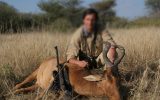The Ministry of Environment, Forestry and Tourism (MEFT) hosted a national conference on Human Wildlife Conflict (HWC) management. The three (3) day conference that ended on 12th May took place in Windhoek and consisted of a variety of speakers that shared critical inputs on the management of human wildlife conflict.
The gathering noted and discussed the different types of conflicts with specific focus on species such as elephants, lions, crocodiles, hippos, leopard, wild dogs and hyenas that are involved in such conflicts.
It have been noted that resource shortage presents a challenge in the management and presentation of Human Wildlife Conflict.
The deputy director for human wildlife conflict management in the North Central regions, Rehabeam Erckie gave a presentation of the human wildlife conflict situation in areas inside conservancies and outside conservancies. According to him; in the north central regions, human-wildlife conflict is recorded to be highest within Oshikoto region. For livestock losses outside conservancies, Oshikoto recorded a total of 277 human-wildlife conflict incidence as from 2018 – 2022. Attacks have been recorded on cattle, donkey, goat, horse and sheep. Hyenas have been recorded to be most responsible for livestock losses hence a stronger need for a management intervention.
In Omaheke region, some farmers (communal, resettlement, commercial) have resorted to using Anatolian/Kangal breed and mongrel as a tool to minimize their small stock losses. About 91% of participating farmers reported reduction in livestock losses.
It have been noted that there is an increasing number of wild animals across the country and there is a need to manage populations at acceptable levels. Emphasis was also made on creating an understanding that human wildlife conflict is not the responsibility of government alone, and therefore communities and all other stakeholders should make resources available and support government in the management of human wildlife conflict.
The conference ended calling for intensified implementation of management methods and techniques which includes provision of water to game; provision of water to communities; identification and maintenance of wildlife corridors; collaring of wild animals, putting down of problems causing animals; translocation of problem causing animals to appropriate areas; building of stronger livestock predator proof kraals and providing resources to aide community based interventions; development and implementation of integrated Land Use management plans for each region and ensuring that there is a predator prey balance in all areas amongst other management.




















